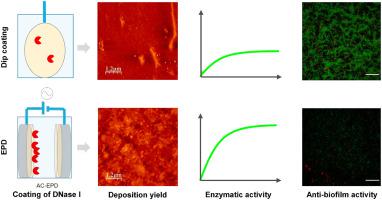Analytica Chimica Acta ( IF 5.7 ) Pub Date : 2022-06-02 , DOI: 10.1016/j.aca.2022.340022 M K Aktan 1 , M Van der Gucht 2 , H Hendrix 2 , G Vande Velde 3 , K Baert 4 , T Hauffman 4 , M S Killian 5 , R Lavigne 2 , A Braem 1

|
Implant-associated infections (IAIs) can cause serious problems due to the difficult-to-treat nature of the biofilms formed on the implant surface. In mature biofilms, the matrix, which consists of polysaccharides, proteins, lipids and extracellular DNA (eDNA), forms a protective environment for the residing bacteria, shielding them from antibiotics and host defenses. Recently, the indirect prevention of biofilm growth through the degradation of eDNA using an enzyme, such as deoxyribonuclease (DNase) I, has gained attention and is regarded as a promising strategy in the battle against IAIs. In this study, coatings of DNase I were applied on titanium implant materials and their anti-infective properties were investigated. First, the effectiveness of alternating current electrophoretic deposition (AC-EPD) as a novel processing route to apply DNase I on titanium was examined and compared with the commonly applied diffusion methodology (i.e. classic dipping). For the same processing time, the use of AC-EPD in combination with a polydopamine (PDA) coupling chemistry on the titanium electrode surface significantly increased the protein deposition yield as compared to classic dipping, thereby yielding homogeneous coatings with a thickness of 12.8 nm and an average surface roughness, Sa, of ∼20 nm. X-ray photoelectron spectroscopy confirmed the presence of peptide bonds on all DNase-coated substrates. Time-of-flight secondary ion mass spectrometry detected a more dense DNase I layer in the case of AC-EPD for electrodes coupled as anode during the high-amplitude half cycle of the AC signal. The enzyme activity, release kinetics, and shelf life of DNase I coatings were monitored in real-time using a quantitative qDNase assay. The activity of DNase I coatings produced using AC-EPD was three time higher than for coatings prepared by classic dipping. For both deposition methods, a high initial burst release was observed within the first 2 h, while some activity was still retained at the surface after 7 days. This can be explained by the stable attachment of a small fraction of DNase to the surface through covalent bonding to the PDA layer, while superimposing DNase deposits were only loosely bound and therefore released rapidly upon immersion in the medium. Interestingly, coatings prepared with AC-EPD exhibited a prolonged, gradual release of DNase activity. The AC-EPD DNase coatings significantly reduced biofilm formation of both Staphylococcus epidermidis and Pseudomonas aeruginosa up to 20 h, whereas DNase coatings prepared by short classic dipping only reduce S. epidermidis biofilm formation, and this to a lesser extent as compared to AC-EPD DNase coatings. Overall, this study indicates that AC-EPD allows to rapidly concentrate DNase I on PDA-functionalized titanium, while maintaining the enzyme activity and anti-infective ability. This highlights the potential of AC-EPD as a time-efficient coating strategy (as opposed to the much slower dip-coating methodologies) for bioactive molecules in a wide variety of biomedical applications.
中文翻译:

交流电泳沉积在聚多巴胺功能化钛表面上的抗感染 DNase I 涂层
由于种植体表面形成的生物膜难以治疗,种植体相关感染 (IAI) 会导致严重问题。在成熟的生物膜中,由多糖、蛋白质、脂质和细胞外 DNA (eDNA) 组成的基质为居住的细菌形成保护环境,保护它们免受抗生素和宿主防御的影响。最近,通过使用脱氧核糖核酸酶 (DNase) I 等酶降解 eDNA 来间接防止生物膜生长受到关注,并被认为是对抗 IAI 的一种有前途的策略。在这项研究中,DNase I 涂层被应用于钛种植体材料,并研究了它们的抗感染特性。第一的,交流电电泳沉积 (AC-EPD) 作为一种在钛上应用 DNase I 的新工艺路线的有效性进行了检查,并与常用的扩散方法(即经典浸渍法)进行了比较。在相同的处理时间下,与经典浸渍相比,在钛电极表面上使用 AC-EPD 与聚多巴胺 (PDA) 偶联化学显着提高了蛋白质沉积产量,从而产生了厚度为 12.8 nm 的均匀涂层和平均表面粗糙度,S一个,约 20 nm。X 射线光电子能谱证实所有 DNase 包被的底物上都存在肽键。在 AC-EPD 的情况下,飞行时间二次离子质谱法检测到在 AC 信号的高振幅半周期期间作为阳极耦合的电极的更密集的 DNase I 层。使用定量 qDNase 测定实时监测 DNase I 涂层的酶活性、释放动力学和保质期。使用 AC-EPD 制备的 DNase I 涂层的活性是传统浸渍制备涂层的三倍。对于这两种沉积方法,在前 2 小时内观察到较高的初始爆发释放,而在 7 天后,一些活性仍保留在表面。这可以通过小部分 DNase 通过与 PDA 层的共价结合稳定地附着在表面上来解释,而叠加的 DNase 沉积物只是松散结合,因此在浸入介质后迅速释放。有趣的是,用 AC-EPD 制备的涂层表现出延长的、逐渐释放的 DNase 活性。AC-EPD DNase 涂层显着减少了两者的生物膜形成表皮葡萄球菌和铜绿假单胞菌长达 20 小时,而通过短经典浸渍制备的 DNase 涂层仅减少表皮葡萄球菌生物膜的形成,与 AC-EPD DNase 涂层相比,这在较小程度上减少。总体而言,这项研究表明 AC-EPD 允许将 DNase I 快速浓缩在 PDA 功能化钛上,同时保持酶活性和抗感染能力。这凸显了 AC-EPD 作为生物活性分子在各种生物医学应用中的高效涂层策略(相对于慢得多的浸涂方法)的潜力。











































 京公网安备 11010802027423号
京公网安备 11010802027423号